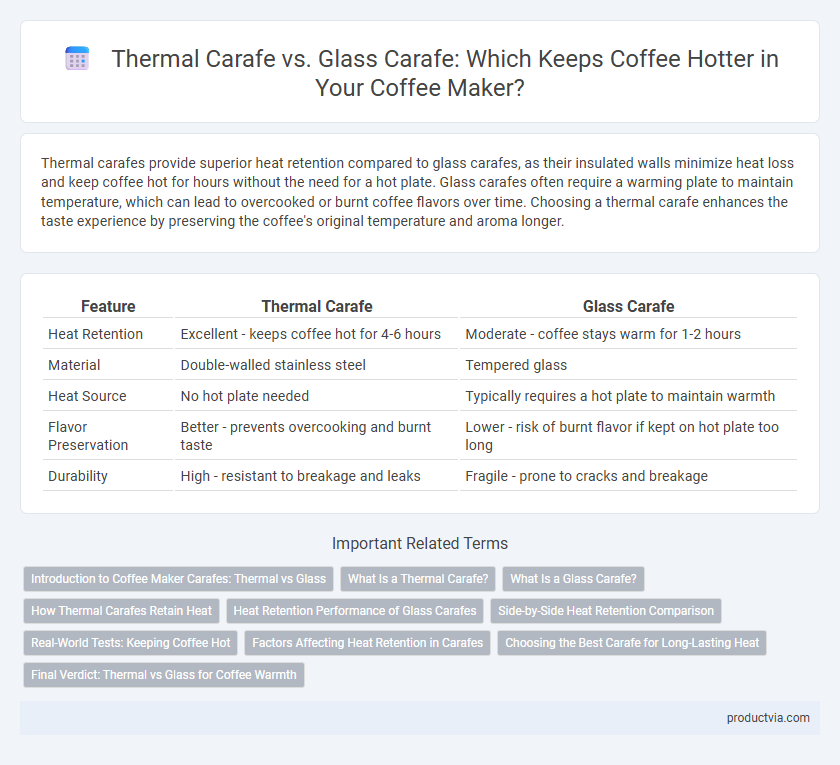Thermal carafes provide superior heat retention compared to glass carafes, as their insulated walls minimize heat loss and keep coffee hot for hours without the need for a hot plate. Glass carafes often require a warming plate to maintain temperature, which can lead to overcooked or burnt coffee flavors over time. Choosing a thermal carafe enhances the taste experience by preserving the coffee's original temperature and aroma longer.
Table of Comparison
| Feature | Thermal Carafe | Glass Carafe |
|---|---|---|
| Heat Retention | Excellent - keeps coffee hot for 4-6 hours | Moderate - coffee stays warm for 1-2 hours |
| Material | Double-walled stainless steel | Tempered glass |
| Heat Source | No hot plate needed | Typically requires a hot plate to maintain warmth |
| Flavor Preservation | Better - prevents overcooking and burnt taste | Lower - risk of burnt flavor if kept on hot plate too long |
| Durability | High - resistant to breakage and leaks | Fragile - prone to cracks and breakage |
Introduction to Coffee Maker Carafes: Thermal vs Glass
Thermal coffee carafes, constructed with insulated stainless steel, excel in heat retention by maintaining coffee temperature for several hours without a warming plate. Glass carafes, typically placed on hot plates, offer visibility to monitor coffee levels but tend to lose heat faster due to less insulation. Choosing between thermal and glass carafes impacts the overall coffee experience by balancing taste preservation with convenience and durability.
What Is a Thermal Carafe?
A thermal carafe is an insulated container designed to keep coffee hot for extended periods without a hot plate, using double-walled stainless steel construction to minimize heat loss. Unlike glass carafes that rely on a warming plate and can lead to burned coffee over time, thermal carafes maintain optimal temperature without altering flavor. This advanced heat retention method ensures fresh-tasting coffee for hours, making it ideal for lengthy consumption.
What Is a Glass Carafe?
A glass carafe is a coffee pot made from heat-resistant glass, designed to brew and serve coffee with a clear view of the liquid inside. While it offers aesthetic appeal and allows users to monitor the coffee level, its heat retention capacity is lower compared to thermal carafes, often requiring a warming plate to keep coffee hot. Glass carafes are usually preferred for their classic look and ease of cleaning, despite the need for external heat sources to maintain optimal temperature.
How Thermal Carafes Retain Heat
Thermal carafes retain heat through double-walled vacuum insulation that minimizes heat loss by preventing air conduction and convection. This design creates an airtight seal that traps heat inside, ensuring coffee stays hot for several hours without requiring an external heat source. In contrast, glass carafes rely on a hot plate to maintain temperature, which can cause over-brewing and uneven heating.
Heat Retention Performance of Glass Carafes
Glass carafes typically have lower heat retention compared to thermal carafes, causing brewed coffee to cool more quickly. Their single-wall construction allows heat to escape faster, which can lead to a weakened flavor if coffee sits too long. For optimal heat retention, especially in maintaining temperature for extended periods, thermal carafes outperform glass counterparts significantly.
Side-by-Side Heat Retention Comparison
Thermal carafes maintain coffee temperature significantly longer than glass carafes, often preserving heat for up to 4-6 hours without a hot plate. In side-by-side heat retention tests, thermal carafes typically lose only 5-10degF over two hours, whereas glass carafes can drop 20-30degF in the same timeframe when placed on a warming plate. The insulated double-wall construction of thermal carafes provides superior heat retention, making them ideal for extended coffee freshness.
Real-World Tests: Keeping Coffee Hot
Thermal carafes excel in real-world tests by maintaining coffee temperatures above 140degF for up to 4-6 hours, significantly outperforming glass carafes that typically lose heat within 30-60 minutes without a warming plate. The insulated stainless steel construction of thermal carafes minimizes heat loss through conduction and evaporation, preserving coffee flavor and freshness longer. Glass carafes often rely on external heating elements which can degrade taste over time, making thermal carafes the preferred choice for sustained heat retention in coffee makers.
Factors Affecting Heat Retention in Carafes
Thermal carafes excel in heat retention due to double-walled vacuum insulation, minimizing heat loss and maintaining coffee temperature for several hours without the need for a hot plate. Glass carafes rely on external heating elements to keep coffee warm, which can lead to uneven heating and potential flavor degradation over time. Factors affecting heat retention include material conductivity, insulation quality, lid seal efficiency, and whether the carafe is kept on a warming plate or insulated standalone.
Choosing the Best Carafe for Long-Lasting Heat
Thermal carafes excel in heat retention due to their insulated stainless steel construction, keeping coffee hot for several hours without a warming plate. Glass carafes, while visually appealing and compatible with most drip coffee makers, tend to lose heat faster and rely on hot plates that may alter the coffee's taste over time. Choosing a thermal carafe ensures longer-lasting heat and better flavor preservation, ideal for coffee enthusiasts seeking fresh taste throughout the day.
Final Verdict: Thermal vs Glass for Coffee Warmth
Thermal carafes excel in heat retention, keeping coffee warm for longer periods without the need for a hot plate, which can alter the brew's flavor. Glass carafes typically require a warming plate, leading to faster heat loss and a higher risk of burnt or bitter coffee over time. For maintaining optimal coffee warmth and preserving flavor, a thermal carafe is the superior choice.
Thermal carafe vs Glass carafe for heat retention Infographic

 productvia.com
productvia.com